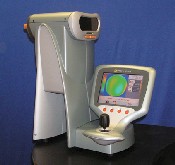Q. Will there ever be a customized spectacle lens for patients with keratoconus?

A. There may be. Technology introduced at the American Academy of Optometry meeting last month combines standard refraction with wavefront technology to create customized spectacle lenses.
The system, called Z-View technology (Ophthonix Inc.), consists of the Z-View aberrometer and a new method for producing spectacle lenses. The Z-view aberrometer utilizes a holographic grid to measure higher- and lower-order aberrations while the patient fixates on a far point. It will measure all aberrations of the eye that contribute to a blurred retinal image, going beyond what we measure in a normal refraction, says San Diego optometrist Jerome Legerton.
Ophthonix CEO Andreas Dreher, Ph.D., says that Z-lens technology differs from traditional methods for prescribing lenses, which remove material from the lens blank to create the prescription. First, you conduct the eye exam with the Z-View aberrometer, an objective, through-the-lens, binocular instrument based on the theory of wavefront measurements. The instrument measures aberrations in a patients eye, then produces a digital prescription, turns it into a bar code and passes it on to the lens programmer. The programmer translates the information and applies it to the lens, much in the way information is burned to a CD.
The proprietary spectacle lens is made in a sandwich type construction with a front, back and middle of the lens. The index of refraction in the center membrane can be altered to correspond with the measurements of higher-order aberrations (HOA), Dr. Legerton says.
So, potentially, this technology could allow you to prescribe tailored lenses for keratoconus patients.
This method, dubbed vision optimization, allows vision correction to within 0.01D. This kind of custom correction allows us to correct the full gamut of refractive problems that present in our offices, says Dr. Legerton.
A study presented at the Ameri-can Academy of Ophthalmology meeting evaluated 30 emmetropic patients with 20/25 or better uncorrected visual acuity. Participants were randomly fit with a Z-lens in one eye, a plano lens in the other, or some combination of the two. Researchers measured contrast sensitivity and low- and high-contrast visual acuity. Statistically significant results were seen with the Z-lens.1

The Z-View aberrometer.
Paul Karpecki, O.D., of Olathe, Kan., believes the first group of patients to benefit from this technology will likely be patients who had LASIK and want better nighttime driving vision. One day, em-metropes may come into our offices wanting better vision, he says.
Q. Are there any drawbacks or limitations to this new technology?
A. These lenses will require precision fitting, much as with progressive addition lenses. Dr. Legerton explains, The HOA correction will be provided in one or more spots that must be aligned for each eye just like channels in progressive lenses. Improper placement and eyewear that is vertically misaligned will likely sabotage the value of those corrections. You will need to place the HOA correction spot differently depending on the patients visual demands.
For most patients, misalignment or a view outside the specified spot will only reduce vision to the level of conventional spectacles. How-ever, this could be especially difficult for patients with keratoconus or post-surgical aberrations.
There is also a question of cerebral plasticity. We have appreciated the difference between sight and vision for years. We may find some patients who can demonstrate 20/8 visual acuity, but report spatial distortion to which they cannot adapt, Dr. Legerton says.
Patient response to these lenses will determine their usage.
1. Binder P. Poster. American Academy of Ophthalmology, Anaheim 2003.

